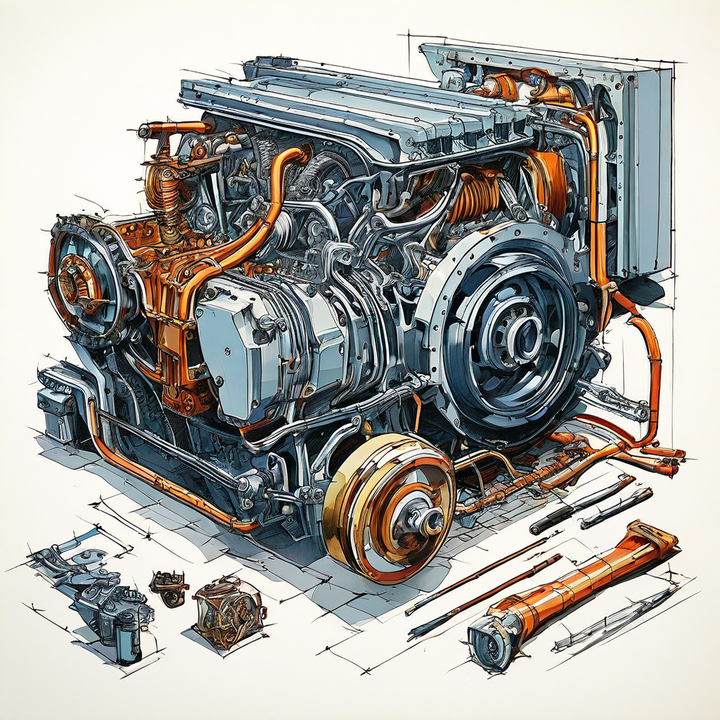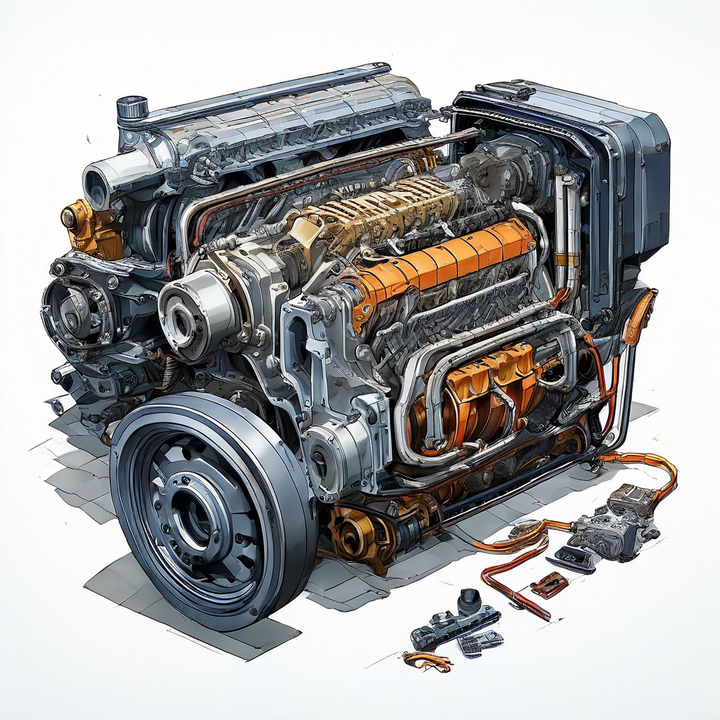


A lean running engine is a condition where the air-fuel mixture contains too much air and not enough fuel. This imbalance can lead to various issues, including reduced performance, increased emissions, and potential engine damage if left unaddressed. Understanding the causes and symptoms of a lean running engine is crucial for proper diagnosis and repair.

In this article, I'll share my expertise and walk you through the process of diagnosing and fixing a lean-running engine. We'll explore the main causes, inspection techniques, repair procedures, and preventive measures to ensure your vehicle runs smoothly and efficiently.
Before we dive into the solutions, it's essential to understand the common culprits behind a lean-running engine. Here are some of the most frequent causes:
| Cause | Description |
|---|---|
| Vacuum Leaks | Leaks in the intake manifold gaskets, hoses, or connections allow excess air into the engine, creating an imbalance in the air-to-fuel ratio. |
| Fuel System Issues | A faulty or weak fuel pump may not supply enough fuel pressure or volume to the injectors, resulting in insufficient fuel delivery. Clogged or dirty fuel injectors can also restrict fuel flow. |
| Sensor Malfunctions | Faulty oxygen (O2) sensors provide inaccurate readings, causing improper fuel adjustments. A dirty or defective mass airflow (MAF) sensor can miscalculate the incoming air volume, leading to insufficient fuel delivery. |
| Exhaust System Problems | Exhaust leaks before the O2 sensors allow unmetered air into the exhaust stream, creating a lean condition. A clogged catalytic converter can restrict exhaust flow, increasing backpressure and contributing to a lean mixture. |
Identifying the root cause of a lean-running engine is crucial for effective repairs. Here are the steps I typically follow during the inspection and diagnosis process:
I start by visually inspecting the intake and exhaust systems for any obvious signs of damage, such as loose connections, damaged hoses, or gasket leaks. I may use a vacuum tester or smoke machine to pinpoint the exact location of vacuum leaks.
Next, I perform a fuel pressure test to check the fuel pump and overall system pressure. This helps me determine if the fuel delivery is adequate or if there are any issues with the pump or injectors.

Using a scan tool, I check the readings from the oxygen sensors and mass airflow (MAF) sensor. Faulty sensors can provide inaccurate data, leading to improper fuel adjustments and a lean condition.
I visually inspect the exhaust system for any leaks using a smoke machine or leak detector. Additionally, I check the catalytic converter for blockages by monitoring the exhaust backpressure.
During the inspection process, I look for specific signs that indicate a lean condition:
Rough idling
Misfiring
Lack of power
Poor acceleration
White or light gray spark plug tips
Trouble starting or stalling
Check engine light illumination with lean-related diagnostic trouble codes (DTCs)
Once the root cause of the lean condition has been identified, it's time to address the issue with the appropriate repair procedures. Here are some common repairs I perform:
| Repair | Description |
|---|---|
| Vacuum Leak Repairs | Locate and repair or replace any damaged vacuum hoses, gaskets, or connections. Ensure all clamps and fittings are tight and secure. |
| Fuel System Repairs | Replace the fuel pump if the fuel pressure is low, clean/replace clogged fuel injectors, or replace faulty fuel pressure regulators. |
| Sensor Replacements | Replace faulty oxygen sensors or mass airflow (MAF) sensor following the manufacturer's procedures. |
| Exhaust System Repairs | Repair or replace any exhaust leaks before the O2 sensors. Replace a clogged catalytic converter if backpressure is excessive. |
Throughout the repair process, I follow all safety precautions when working on fuel systems and engines. Using proper tools and techniques is crucial to avoid damaging components. After completing the repairs, I clear any diagnostic trouble codes and verify proper engine operation.
While fixing the immediate issue is important, taking preventive measures can help avoid future lean-running engine problems.
Maintenance:
Replace air filters, fuel filters, and spark plugs as recommended
Perform regular tune-ups and inspections to identify potential issues early on
Proper Operation:
Avoid excessive idling or high engine loads until the lean condition is resolved
Use high-quality fuel and follow the recommended octane rating
Promptly address any engine warning lights or drivability issues
The cost of repairing a lean-running engine can vary significantly depending on the underlying cause and the extent of the repairs required.
| Repair | Approximate Cost Range |
|---|---|
| Vacuum Leak Repairs | $100 - $300 |
| Fuel Pump Replacement | $300 - $800 |
| Fuel Injector Cleaning or Replacement | $200 - $800 (per injector or set) |
| Oxygen Sensor Replacement | $200 - $400 (per sensor) |
| Mass Airflow (MAF) Sensor Replacement | $200 - $400 |
| Exhaust System Repairs | $200 - $1,000 |
| Catalytic Converter Replacement | $800 - $2,000 |
These costs can vary based on your vehicle's make, model, location, and the labor rates of the repair shop. If multiple components need to be replaced or if there is internal engine damage due to prolonged lean conditions, the overall cost can be significantly higher.
To minimize costs, I always recommend addressing lean-running issues promptly and following the manufacturer's recommended maintenance schedule. This can help prevent further damage and more expensive repairs down the line.
Fixing a lean-running engine requires a systematic approach and a thorough understanding of the various components and systems involved. By following the inspection and diagnosis procedures outlined in this article, you can identify the root cause of the lean condition and take the necessary steps to repair it.
Remember, addressing lean-running issues promptly is crucial to prevent potential engine damage and ensure your vehicle's optimal performance and efficiency. Regular maintenance and proper operation are also key to avoiding future occurrences.
If you're ever unsure about the diagnosis or repairs needed, don't hesitate to seek professional assistance from a qualified mechanic. With the right knowledge and expertise, you can keep your engine running smoothly and efficiently for years to come.
Common signs include rough idling, misfiring, lack of power, poor acceleration, white or light gray spark plug tips, trouble starting or stalling, and the check engine light illumination with lean-related diagnostic trouble codes.
Vacuum leaks in the intake manifold gaskets, hoses, or connections allow excess air into the engine, creating an imbalance in the air-to-fuel ratio, resulting in a lean condition.
Faulty oxygen (O2) sensors provide inaccurate readings, causing improper fuel adjustments, which can lead to a lean condition.
Yes, a clogged catalytic converter can restrict exhaust flow, increasing backpressure and contributing to a lean mixture.
Perform a fuel pressure test to check the fuel pump and overall system pressure, which can help determine if the fuel delivery is adequate or if there are any issues with the pump or injectors.
A dirty or defective mass airflow (MAF) sensor can miscalculate the incoming air volume, leading to insufficient fuel delivery and a lean condition.
Preventive measures include regular maintenance, replacing air filters, fuel filters, and spark plugs as recommended, performing tune-ups and inspections, using high-quality fuel, and promptly addressing any engine warning lights or drivability issues.
Yes, excessive idling or high engine loads can exacerbate a lean condition, so it's recommended to avoid these practices until the lean condition is resolved.
The approximate cost range for replacing a catalytic converter is $800 to $2,000, depending on the vehicle's make, model, location, and labor rates.
Addressing lean-running issues promptly is crucial to prevent potential engine damage and ensure optimal vehicle performance and efficiency, as well as to avoid more expensive repairs down the line.

Sarah isn't your average gearhead. With a double major in Mechanical Engineering and Automotive Technology, she dived straight into the world of car repair. After 15 years of turning wrenches at dealerships and independent shops, Sarah joined MICDOT to share her expertise and passion for making cars run like new. Her in-depth knowledge and knack for explaining complex issues in simple terms make her a valuable asset to our team.












